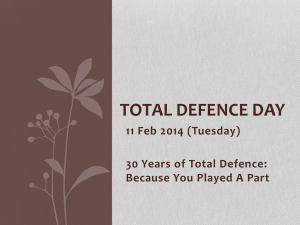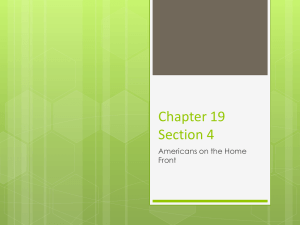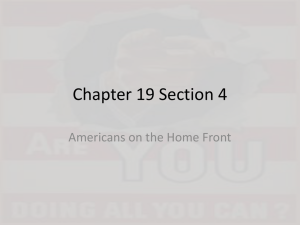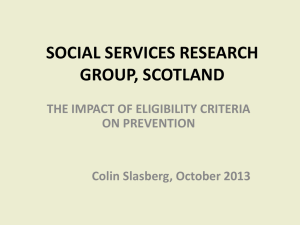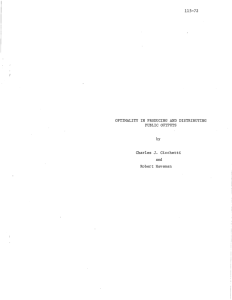Rationing and Pricing Strategies for Congestion Mitigation
advertisement
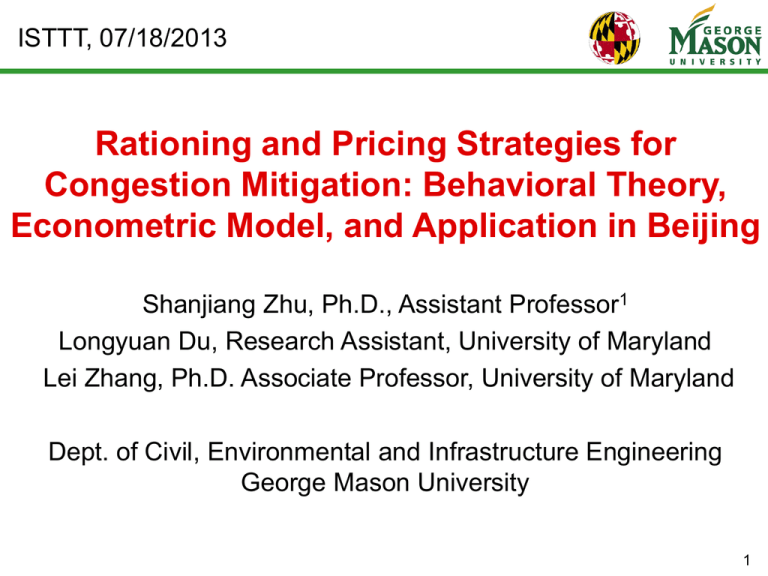
ISTTT, 07/18/2013 Rationing and Pricing Strategies for Congestion Mitigation: Behavioral Theory, Econometric Model, and Application in Beijing Shanjiang Zhu, Ph.D., Assistant Professor1 Longyuan Du, Research Assistant, University of Maryland Lei Zhang, Ph.D. Associate Professor, University of Maryland Dept. of Civil, Environmental and Infrastructure Engineering George Mason University 1 Fighting Growing Congestion Concerns about pricing • • • • • Similar to tax Hefty transaction cost Distributional effects Privacy concerns … Source: wantchinatimes.com Source: MnDOT Road Pricing Rationing policy could be useful when • • dealing with basic life necessities (e.g. water in Renwick and Archibald (1998)) dealing with inelastic demands (Guesnerie and Roberts, 1984) 2 Examples of Usage Restriction Driving Restriction Based on License Plate Number • Today, 2 and 7 • Tomorrow, 3 and 8 Beijing, China Source: BVCA News San José, Costa Rica Source: Wikipedia 3 A Growing List … Rome, 45 B.C. Athens, Greece, 1982 Santiago, Chile, 1986 Mexico City, Mexico, 1989 São Paulo, Brazil, 1996 Bogotá, Colombia, 1998 La Paz, Bolivia, 2003 San José, Costa Rica, 2005 Beijing, China, 2008 ... 4 Examples of Ownership Quota Singapore, Vehicle Quota System(VQS), 1990 Shanghai, License Plate Auction, 2001 Beijing, Vehicle Lottery, 2010 Guangzhou, 50% Lottery 50% Auction, 2012 … 5 Literature Empirical studies: • “Day without a Car” policy in Mexico City did not achieve the policy objective. (Eskeland and Feyzioglu, 1997) • Vehicle usage restriction periods in Bogotá, Columbia keep on expanding. (Davis, 2008) • Singapore experience exhibits mixed results. (Smith and Chin, 1997) • … Modeling: • Hybrid strategy of rationing and pricing (Daganzo, 1995) • Field experiment in Bay Bridge area, California (Nakamura and Kockelman, 2002) • A framework to deal with both short-term and long-term responses to vehicle usage rationing policies. (Wang, Yang, and Han, 2010) • … 6 Objectives • Develops a welfare analysis framework for rationing policies • Compares welfare effects of the two different rationing policies, and that of the more popular pricing policy. • Explores how to implement models on real networks. 7 Framework Supply Models • BPR Model • Vickery’s Model Demand Models • Ownership • VMT Stylized Network Equilibrium Policies • Ownership rationing • Usage rationing • Pricing Compensation Variation Welfare Changes 8 Model Setup Indirect Utility Function Demand Function Roy’s Identify p : operatingcost C : annualcapitalcost Y : income A : amountof driving : householdcharacteristics • Dubin and McFadden (1984) • Mannering and Winston (1985) • De Jong (1990) • Goldberg (1998) • … 9 Ownership Decision Other Expenses Y Y-C Amin Source: de Jong 1990 VMT 10 Model Setup Supply Function : value of time F : Capacity , : performance parameter 11 Network Equilibrium More congestible network P Less congestible network 12 Welfare Analysis Methods Consumer Surplus (CS) Difference between what I want to pay and what I actually paid for a good or service Compensating Variation (CV) After the policy change, how much do I need to be compensated to stay at the same utility level Equivalent Variation (EV) Before the policy change, how much do I want to pay to avoid the policy change 13 Vehicle Usage Rationing Assuming drivers can not drive on 1 − 𝜆 of days New indirect utility function: VMT choice: 14 Vehicle Usage Rationing A 15 Vehicle Usage Rationing with Induced Demand New equilibrium point Decide CV Price in new equilibrium Price in old equilibrium 16 Vehicle Usage Rationing with Induced Demand Proposition 1: When induce demand is taken into account, vehicle usage rationing policy will always results in a user welfare loss. CVu 0 >0 1 λ 17 Vehicle Ownership Rationing Only λ of households who are willing to buy a car can actually buy a car. 18 Comparison with Road Pricing λq* 19 Comparison with Road Pricing Proposition 2: When road pricing and vehicle ownership rationing are set up in such a way that both policies reduce travel demand by the same amount (or have the same congestion mitigation effects), road pricing will always generate a bigger social welfare gain. Welfare Change of Pricing - Welfare Change of Ownership Rationing h(p**0) 0 p0 p**0 <0 20 Analytical Findings Temporal Substitution of Travel Temporal substitution of travel can affect welfare impact of vehicle usage rationing policy. (If I cannot use my vehicle on Monday for a trip, can I make that trip in another day of the week?) Vehicle Use Rationing Always causes welfare loss if there is perfect temporal substitution of demand Congestion Pricing Is better than vehicle ownership and usage rationing policies 21 Comparing Rationing Policies w/o Sub. 22 Sensitivity Analysis 23 Heterogeneous Users Individual travel decisions: Individual utility: Probability of owning a vehicle: Average driving amount among vehicle owners: 24 Aggregate Demand 25 Network Analysis 26 Beijing Lottery System Welfare changes for three user groups: • Households who should have bought a car without the rationing policy and actually won lottery • Households who should have bought a car without the rationing policy and did not win lottery • Households who would not buy a car without the policy, who were motivated after the policy implementation, and won the lottery 27 Beijing Sketch Network 28 Beijing Sketch Network 29 Conclusions and Policy Implications Avoid Vehicle Use Restriction If the goal is to significantly mitigate congestion. Congestion Pricing is a Better Choice If it can be implemented in ideal conditions. Consider Vehicle Ownership Quota If pricing measures are not feasible. Rationing Policies are More Likely to Succeed If the network is congested and operated near capacity. 30 Future Research Relax Model Assumptions Consider multiple time periods, multiple user types, multiple modes, and multiple OD pairs Conduct Empirical Research Beijing 31 Thank You! Questions and Comments? Shanjiang Zhu, Ph.D., Assistant Professor Civil, Environmental & Infrastructure Engineering George Mason University szhu3@gmu.edu 32

